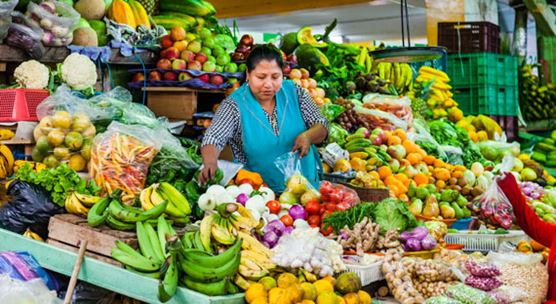
Fruit vendor sells produce at a market stall in Sangolqui, Ecuador, where the new economic plan is expected to restore growth and create more jobs (iStock/PatricioHidalgoP)
Ecuador's New Economic Plan Explained
March 21, 2019
Ecuador has developed a new economic plan designed to put the country’s debt on a firm downward path, create jobs, protect the poor and most vulnerable, and bolster the fight against corruption.
The plan, supported by a US$4.2 billion Extended Fund Facility from the IMF, along with additional financial support from the international community, will give Ecuador the boost needed to restore sustainable growth that benefits all Ecuadorians.
In the following interview, Anna Ivanova, IMF’s mission chief for Ecuador, discusses the details of the economic plan.
Ecuador’s economy has been one of the most stable in Latin America. Why did the country decide to come to the IMF?
Ecuador has enjoyed a healthy economy supported by the dollarization regime—the country uses the US dollar for its currency—and high oil prices. However, oil wealth and dollarization are double-edged swords. Over the past decade, Ecuador’s policies were inconsistent with the dollarization regime. Wage increases outpaced productivity growth and hurt the country’s competitiveness.
The oil price plunge of 2014 and the subsequent US dollar appreciation exposed the underlying weaknesses of the economy. To finance growing fiscal imbalances, the previous government resorted to central bank financing. Public debt doubled over the past five years and international reserves fell to very low levels.
The current government of Ecuador decided to proactively come to the IMF for support to tackle underlying economic vulnerabilities, restore growth, and improve social outcomes.
What does the new economic plan seek to achieve?
Ecuador has committed to a new economic program that seeks to put public debt firmly on a downward path and supports policies that will help lift growth and boost productivity. The program strongly supports the government’s prosperity plan and is based on four key pillars:
- fortify the institutional foundations of Ecuador’s dollarization;
- boost competitiveness and create jobs;
- promote shared prosperity and protect the poor and most vulnerable; and
- improve transparency and strengthen the fight against corruption.
This is an ambitious reform agenda, but these reforms are necessary to strengthen the economy and institutions in Ecuador.
As Ecuador is a dollarized economy, a strong US dollar can raise the price of Ecuador’s goods, thereby hurting the country’s competitiveness in the global market. How does the plan address this challenge?
Raising Ecuador’s competitiveness and raising productivity will require a concerted effort. Since Ecuador uses the US dollar as its currency, it is not able to use exchange rates as a tool to make its exports more competitive in the global market. Therefore, the country will have to rely on policies that allow for internal devaluation instead.
First and foremost, reigning in government spending, particularly through the optimization of the wage bill, will be important to make Ecuador’s exports more attractive. Moreover, allowing for less rigidity in wages and prices could help support external adjustment. This can be achieved through policies that remove rigidities in the labor and product markets and in the financial sector.
How will the program support jobs and more workers in the formal labor market?
In addition to what I mentioned, other reforms to make the country an attractive business destination and to boost growth and more formal employment include reviewing the system of taxation and removing obstacles to business formation and operation. Other key reforms include taking steps to encourage private investment, deepening the capital markets, opening international trade, and creating better conditions for participation of women in the labor market.
How does Ecuador fare on social indicators and how will the government protect social spending under the plan?
Ecuador has made substantial gains in reducing poverty over the past two decades, since the country adopted dollarization. The percentage of the population living below the national poverty line has fallen from 64.4 percent in 2000 to 21.5 percent in 2017 and the share of the population living below US$1.90 a day fell from 28.2 percent in 2000 to 3.6 percent in 2016.
While these are notable achievements, poverty rates among the rural and indigenous populations remain high. While social assistance spending is high by regional standards and there is good coverage of those in the bottom 20 percent of the income distribution, the authorities see scope to do more. Therefore, the government included measures in the plan to continue protecting the poor and most vulnerable. These include:
- increasing spending on social assistance programs, such as Bono de Desarrollo Humano, Bono Joaquin Gallegos Lara as well as extending the coverage of non-contributory pensions;
- developing a social registry to improve targeting of social programs; and
- increasing the efficiency and quality of primary education and health spending to improve outcomes and enhance the quality of the labor force and external competitiveness of the economy.
As you mentioned, one of the key priorities of the new plan is to continue to improve transparency and bolster the fight against corruption. Why does this matter for the economy?
The government is committed to promoting transparency and fighting corruption in the country because it impacts all corners of the economy. These efforts will help improve running businesses, lower public financing costs, and support private investment and jobs. Some key measures include:
- anti-corruption legislation, which will enhance the independence and power of law enforcement agencies and the judiciary, as well as improve access to government operation information;
- publishing central bank financial statements as they become available in conformance with international financial reporting standards;
- developing anti-money laundering and countering financial terrorism (AML/CFT) national risk assessment that properly prioritizes corruption-related threats and incidents; and
- gaining membership into Extractive Industries Transparency Initiative to help improve transparency in the oil sector.







